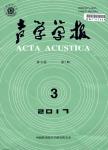版权所有:内蒙古大学图书馆 技术提供:维普资讯• 智图
内蒙古自治区呼和浩特市赛罕区大学西街235号 邮编: 010021

作者机构:Automatic Control Institute Harbin Engineering University Harbin 150001 China Dalian Scientific Test and Control Technology Institute Dalian 116013 China School of Computer Science and Technology Harbin Engineering University Harbin 150001 China
出 版 物:《Shengxue Xuebao/Acta Acustica》 (Shengxue Xuebao)
年 卷 期:2006年第31卷第2期
页 面:146-150页
核心收录:
学科分类:0810[工学-信息与通信工程] 07[理学] 081203[工学-计算机应用技术] 082403[工学-水声工程] 08[工学] 070206[理学-声学] 0804[工学-仪器科学与技术] 0835[工学-软件工程] 0824[工学-船舶与海洋工程] 0702[理学-物理学] 0812[工学-计算机科学与技术(可授工学、理学学位)]
主 题:Object recognition
摘 要:Based on Perception Linear Prediction (PLP), an approach to extract features from underwater target signal is presented. The method is the simulation of hearing property of human beings. Through the auditory psychology, three auditory spectrums are estimated, and they are Critical band, Equal-loudness curve and Intensity-loudness power. Then, a twelve-dimension feature vector is obtained. The vector is also a twelve-order all-pole model and it is robust. With the feature vector, the training and recognition processes are performed. The real sea experiments prove that human ear is at different level of sensitivity with different frequency bands where six kinds of radiated noises exist respectively, that the underwater target features are robust, that the dimension is relatively lower and the computation is less expensive and the recognition ratio may arrive 91% to six kinds of underwater target noise.